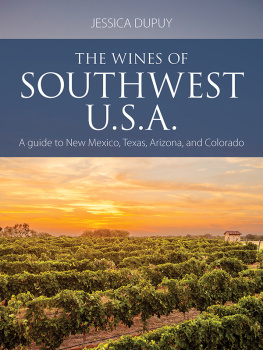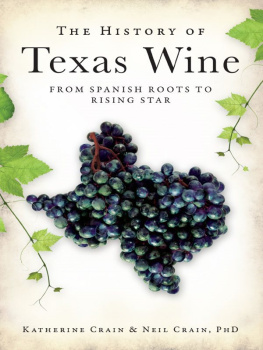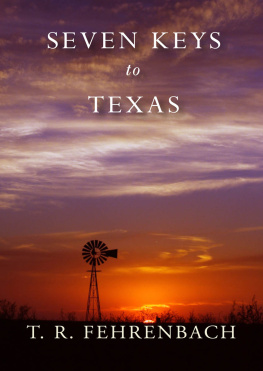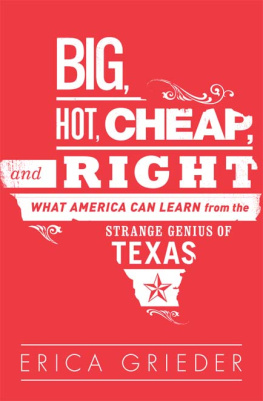
Gretchen Glasscock 2020
All rights reserved. No part of this book may be reproduced in any form without the prior permission, except for brief quotations in critical articles or reviews. In such cases, a credit to the original source is to be indicated.
First Edition, 2020
ISBN: 978-1-7360176-0-9 (Hardcover)
ISBN: 978-1-7360176-1-6 (Paperback)
ISBN: 978-1-7360176-2-3 (ebook)
www.advancingtexaswine.com
Editor: Barbara Noe Kennedy
Book cover design/Interior design: Asya Blue
Deepest thanks to Leon Adams, author of The Wines of America and expert on wine laws in the United States, who showed us where the goalposts were; and Pike Powers, legislative powerhouse who strategized and crafted the Farm Winery Bill, then recruited the legislative team that aggressively pushed it down the field and over the line, particularly the combative and courageous Representative John Wilson, who stopped the opposition in their tracks several times; and in my own Bexar County, Representative Frank Tejeda, a loyal colleague and supportive professional friend, warm and personable and a true champion. Without these warriors and, indeed, my entire viticultural, winemaking and communications teams, there would be no historic Farm Winery Act. On behalf of all winegrowers and wine lovers in Texas, I would like to thank them all and hope they attain their rightful place in the honored annals of Texas wine history. I also would like to thank all the winegrowers who have bravely chosen this pioneering path of developing Texas wines.
The discovery of a new vineyard does more for the happiness of mankind than the discovery of a new star.
Jean Anthelme Brillat-Savarin
1755-1826
Looking back over 30 years, I feel that Glasscock had a strong suit and it was Vision with a capital V.
Vintage Texas

This book provides new details recorded by a Texas wine pioneer, advocate, activist and entrepreneur who lived it. Working with dedicated professionals who believed, as I did, that the future of Texas wine held great promise, I was a vigorous, groundbreaking participant in challenging the first definitions of Texas grape-growing regions, planting the first commercial vinifera grape vineyard in Texas, helping form the Texas Grape Growers Association and passing the historic landmark legislation, the Farm Winery Act, HB 2229, which laid the foundation and enabled the development of a multibillion-dollar Texas wine industry.
This is a tale of epic battles and larger-than-life personalities, including iconic global winemakers, titans of the wine industry, newcomers who wanted to create this groundbreaking new industry and Texas legislators who either caved or fiercely fought the well-financed liquor lobby that had one goal: to kill change.
And we will explore the future of the Texas wine industry, particularly in this present moment of a pandemic that has forced wine-tasting rooms and wine festivals to shut down. The future necessarily will bring in a new era of online wine sales. And we will be prepared to embrace it in a way that will create new prosperity for Texas wine.
CHAPTER ONE

The Judgement of Paris in 1976 was a moment that rocked the world of wine and set it on a different course. This was a moment, at a well-known, respected and well-publicized blind wine tasting in Paris, with French judges, that two California wines took first place over their French counterparts, proving that, given a level playing field, California and American wines could compete with the top wines in the world.
Stags Leap Wine Cellars walked off with top honors as a California Cabernet, against top French Bordeaux wines, including Chteau Mouton Rothschild Chteau Montrose and Chteau Haut-Brion . Chateau Montelenas Chardonnay, from Napa Valley, won the white wine category in a field that included some of the best and most famous French Burgundies, including the illustrious Montrachet, a Grand Cru vineyard in the Cte de Beaune.
Make no mistake: The wine industry is a competitive business. The French were shocked and did not take this upset willingly or graciously. One French judge, outraged, asked for her ballot back. But the die was cast.
American wines began to break the stranglehold French wines and, in fact, French dining establishments had on the United States food and beverage scene. Prominent and influential celebrity chefs, such as James Beard, endorsed and promoted fresh and wholesome food and American wines, a break from the classic, dark French restaurants, with their heavy sauces and rich, classic French dishes, stars of a time when fresh food was not so bountiful and easily procured. Without denying the high quality of many of the top French restaurants and French wines, much of what they achieved has to be attributed to the success of their marketing, their aura of sophistication and their exclusivity.
What might be considered a second and many subsequent Judgement of Paris moments of awakening have now taken place, putting Texas wines at the center of a new and revised wine universe. One of the latest, the 2020 San Francisco Chronicle Wine Competition (SFCWC), received nearly 6,700 entries from over 1,000 wineries from the United States, Canada and Mexico.
Over 65 judges from a variety of fields representing various North American wine regions completed the judging on January 10, 2020, to determine the best wines in North America. Best of Class awards went to the following Texas wines:
- Brennan Vineyards 2015 Viognier Comanche County
- English Newsom Cellars 2018 Roussanne Texas High Plains
- Longhorn Cellars Brindle Blend Texas
- Lost Draw Cellars 2018 Marsanne Texas High Plains
- Messina Hof Winery 2017 Paulo Blend Texas
- Perissos Vineyard and Winery 2017 Aglianico Texas Hill Country
- Spicewood Vineyards 2017 Tempranillo Texas High Plains
Many more Texas wines won top honors as they have for years. There is no question, in terms of quality, Texas wines have definitely arrived. A look back will tell us how we got to this place and where we go from here.

In the 1970s, we lived in a very different world and a very different grape-growing, wine knowledge and wine consumption culture than we do today.
In the 1970s there was no Google to help with research, no Facebook to network or share ideas, no cell phones to keep in touch. The Beatles released their final album, Let It Be. Disney World opened in Orlando, Florida, with the price of $3.50, as opposed to todays price of $105 for a day pass for those over 10 years old. Seventies fashions featured flower power, bell bottoms, and military surplus.
Fashions in wine were dramatically different as well. Blue Nun, a sweet, white German wine, was the most popular wine in the world. Owner [Peter] Sichel targeted the export market. Beginning in the 1950s, Blue Nun was advertised as a wine that could be drunk throughout an entire meal, thereby eliminating the often intimidating problem of wine and food pairing. Blue Nun can be said to have been the first wine to have been produced and effectively marketed with an international mass market in mind. The brand became spectacularly popular in the United Kingdom and the United States, selling for the same price as a second growth red Bordeaux wine. At its peak of popularity in 19841985, annual sales in the US were 1.25 million cases, with another 750,000 cases sold elsewhere.
Next page









